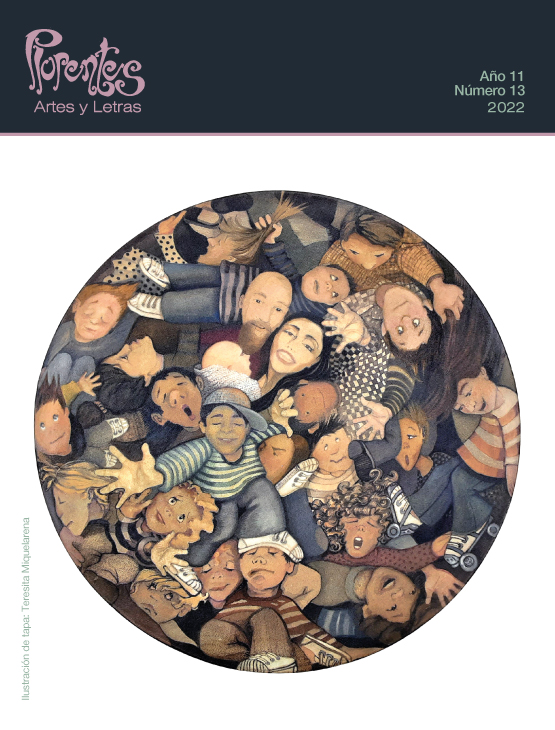What is the purpose behind the different ways of communicating something?
DOI:
https://doi.org/10.24215/18536212e050Keywords:
structures, information, linguistic reflection, interpretation, productionAbstract
This pedagogical proposal, aimed at 2nd- year- students attending the subject Language and text production at the Bachillerato de Bellas Artes, develops a plan to approach the study of information structures in journalistic chronicles. The project, along four classes, favors the analysis of the speaker's perspective about the information they provide in order to widen the communicative competence of students by means of the metalinguistic reflection to support the production and comprehension of texts.
Downloads
References
Aguerre, A. (2017). Texturas reunidas. Proyecto académico y de gestión 18-22. Bachillerato de Bellas Artes, UNLP.
Anijovich, R. y Cappelletti, G. (2017). La evaluación como oportunidad. Buenos Aires: Paidós, Voces de la Educación.
Bajtín, Mijail M. (1982). El problema de los géneros discursivos. En Estética de la creación verbal. México DF: Siglo XXI, pp. 248-293.
Calsamiglia, H. y Tusón Valls, A. (1999). Las cosas del decir. Barcelona: Ariel.
Ciapuscio, G. (1994). Tipos textuales, Buenos Aires: Eudeba.
Ciapuscio, G. (2007). El lugar de la gramática en la producción de textos. Recuperado de https://www.educ.ar/recursos/91290/el-lugar-de-la-gramatica-en-la-produccion-de-textos
Di Tullio, Á. (1997). Manual de Gramática del español. Desarrollos teóricos. Ejercicios. Soluciones. Buenos Aires: Edicial.
Escudier, M. A; Piatti, G. y Tiberi M. L. E. (2007). La reflexión lingüística: un puente entre la gramática y la producción de textos. En: Acevedo, A. (ed), Ideas para una nueva educación. Bachillerato de Bellas Artes, U.N.L.P. La Plata.
Escudier, M. A; Piatti, G. y Tiberi M. L. E. (2007). Reestructuración de la asignatura Lengua y Literatura. En: Acevedo, A.(ed), Ideas para una nueva educación. Bachillerato de Bellas Artes, U.N.L.P. La Plata.
Fernández, S. S. (Agosto 2002). La voz pasiva en español: hacia un análisis discursivo. Trabajo presentado en Romansk Forum XV Skandinaviske romanistkongress. Nr. 16 – 2002/2 Oslo 12. Aarhus Universitet. 75-85. Recuperado de http://www.contrastiva.it/baul_contrastivo/dati/sanvicente/contrastiva/Gram%Altica%20espa%C3B1ola/Fernandez,%20Pasiva.pdf
Ferrari, A. M. y Piatti, G. I. (2007). Los tipos textuales en la enseñanza de ELSE: Hacia una integración de la gramática y los géneros discursivos. Puertas Abiertas (3), 94-98. Recuperado de http://www.memoria.fahce.unlp.edu.ar/art_revistas/pr.4581/pr.4581.pd
Piatti, G. [et al.] (2013). Manual de Gramática del español. La Plata: EDULP. Recuperado de http://sedici.unlp.edu.ar/handle/10915/27878
Real Academia Española (2010). Nueva gramática de la lengua española. Madrid: Espasa.
Serafini, M. T. (2008). Cómo se escribe. Buenos Aires: Paidós.
Published
How to Cite
Issue
Section
License
Copyright (c) 2022 Carola Soares Telles

This work is licensed under a Creative Commons Attribution-NonCommercial-ShareAlike 4.0 International License.
Acorde a estos términos, el material se puede compartir (copiar y redistribuir en cualquier medio o formato) y adaptar (remezclar, transformar y crear a partir del material otra obra), siempre que a) se cite la autoría y la fuente original de su publicación (revista y URL de la obra), b) no se use para fines comerciales y c) se mantengan los mismos términos de la licencia.





















